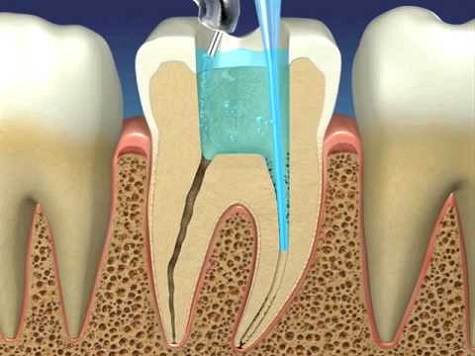|
Endodonci | 24 Korrik 2017 |
Larjet kanalare: nė ēfarė thellėsie duhet tė arrijmė?
Nė trajtimet kanalare njė hap thelbėsor ėshtė pėrfaqėsuar nga larjet kanalare, qė pėrveē se kanė qėllimin pėr dezinfektim kanė dhe atė tė heqjes sė mbetjeve organike dhe inorganike, tė karakterizuara nga kontaminimi bakterial dhe nėse lihen janė burim pėr infeksione tė tjera bakteriale nė tė ardhmen.
Autorė tė ndryshėm nė literaturė kanė sinjalizuar se instrumentet mekanike mund tė japin si efekt tė padėshirueshėm akumulimin e mbetjeve organike dhe inorganike sidomos nė zona ku ka istmus, degėzime kanalare dhe parregullsi anatomike (Paquè et al. 2009, De-Deus et al. 2015, Versiani et al. 2016). Rezulton kėshtu thelbėsore qė tė garantojmė njė irrigim tė vlefshėm dhe efikas qė tė mund tė heqim sasinė mė tė madhe tė mbetjeve edhe nė zonat kanalare qė arrihen me shumė vėshtirėsi.
Efikasiteti i irrigimit bazohet nė shumė variabla, ndėr tė cilat anatomia kanalare, metodika e irrigimit, vėllimi, fluksi dhe lloji i irrigimit, kėshtu si dhe lloji dhe diametri i ages sė pėrdorur pėr larjet. Pėrveē kėtyre faktorėve irrigimi kanalar ėshtė pėrcaktues edhe nė heqjen e mbetjeve organike dhe inorganike (Abou-Rass & Piccinino 1982, Chow 1983, Albrecht et al. 2004, Sedgley et al. 2005, Hsieh et al. 2007).
Sipas njė studimi tė kohėve tė fundit tė publikuar nė International Endodontic Journal, qershor 2017, thellėsia e futjes sė ages sė irrigimit ndikon ndjeshėm nė heqjen e mbetjeve inorganike. Njė majė e ages e pozicionuar 1 mm nga gjatėsia e punimit ka ēuar nė nivele pėrqindje tė heqjes sė mbetjeve tė indit tė fortė pothuajse tre herė mė shumė se ajo e ofruar nga agia e irrigimit e pozicionuar 5 mm nga gjatėsia e punimit.
Autorėt kanė marrė 20 molarė mandibular nė mėnyrė anatomike dhe me pėrmasa morfologjike tė ngjashme nė tė cilėt ishte i pranishėm njė istmus i identifikuar me micro-CT device (SkyScan 1173; Bruker micro-CT, Kontich, Belgium). Janė seleksionuar 20 molarė tė poshtėm me rrėnjė meziale me istmus tė tipit I (nė formė shiriti dhe tė shtrėnguar qė lidh plotėsisht dy kanalet meziale) ose tė llojit III (istmus jo i plotė ekzistues mbi ose nėn njė istmus komplet).
Nė bazė tė thellėsisė sė irrigimit dhėmbėt janė ndarė nė mėnyrė rastėsore nė dy grupe respektivisht me 10 kampione:
- Grupi 1: maja e ages sė shiringės pėr irrigim ēohej deri nė 1mm nga gjatėsia e punimit
- Grupi 2: maja e ages sė shiringės pėr irrigim ēohej deri nė 5 mm nga gjatėsia e punimit (WL).
Instrumentimi kanalar ėshtė kryer me file Reciproc R25 (dimensione tė majės 25, 0,08 konike) dhe ėshtė pėrdorur hipoklorit sodiumi me 5,25% si irrigues.
Larja finale ėshtė kryer me EDTA 17% ndjekur nga uji i bidistiluar.
Kėshtu janė ekzaminuar sėrish kampionet me micro-CT pėr tė kuantifikuar sasinė e mbeturinave inorganike tė mbetura.
Nga rezultatet e shfaqura nga studimi ėshtė parė se me asnjėrėn nga thellėsitė e futjes sė ages pėr irrigim nuk ėshtė mundur tė garantohet njė sistem kanalar plotėsisht pa mbeturina tė mbetura. Thellėsia e futjes sė ages luan njė rol thelbėsor nė heqjen e mbetjeve me njė reduktim domethėnės tė vėllimit nė pėrqindje tė mbetjeve inorganike tė mbetura kur agia ēohet deri nė 1 mm nga gjatėsia e punimit (P<0,005).
Nėn kujdesin e: Lara Figini, Koordinatore Shkencore Odontoiatria33
Pėr mė tepėr:
De-Deus G, Marins J, Silva EJ et al. (2015). Accumulated hard-tissue debris produced during reciprocating and rotary nickel-titanium canal preparation. Journal of Endodontics 41, 676-81.
Paque F, Laib A, Gautschi H, Zehnder M (2009). Hard-tissue debris accumulation analysis by high-resolution computed tomography scans. Journal of Endodontics 35, 1044-7.
Versiani MA, Alves FR, Andrade-Junior CV et al. (2016) Micro-CT evaluation of the efficacy of hard-tissue removal from the root canal and isthmus area by positive and negative pressure irrigation systems. International Endodontic Journal 49, 1079-87.
Abou-Rass M, Piccinino MV (1982). The effectiveness of four clinical irrigation methods on the removal of root canal debris. Oral Surgery, Oral Medicine, Oral Pathology and Endodontics 54, 323-8.
Chow TW (1983). Mechanical effectiveness of root canal irrigation. Journal of Endodontics 9, 475-9.
Albrecht LJ, Baumgartner JC, Marshall JG (2004). Evaluation of apical debris removal using various sizes and tapers of ProFile GT files. Journal of Endodontics 30, 425-8.
Hsieh YD, Gau CH, Kung Wu SF, Shen EC, Hsu PĖ, Fu E (2007). Dynamic recording of irrigating fluid distribution in root canals using thermal image analysis. International Endodontic Journal 40, 11-7.
Sedgley CM, Nagel AC, Hall D, Applegate B (2005). Influence of irrigant needle depth in removing bioluminescent bacteria inoculated into instrumented root canals using real-time imaging in vitro. International Endodontic Journal 38, 97-104.
Perez R, Nevse AA, Belladonna FG, Silva EJNL, E. M. Souza EM, Fidel1 S, Versiani MA, Lima I,Carvalho C & G. De-DeusG.Impact of needle insertion depth on the removal of hard-tissue debris. International Endodontic Journal, 50, 560-568, giugno 2017
Pėrktheu: Erjola Taga




